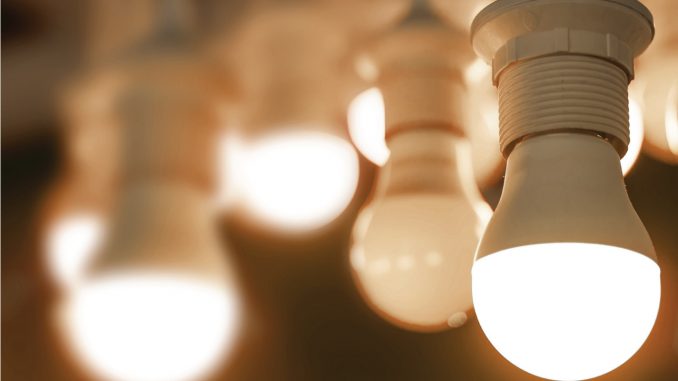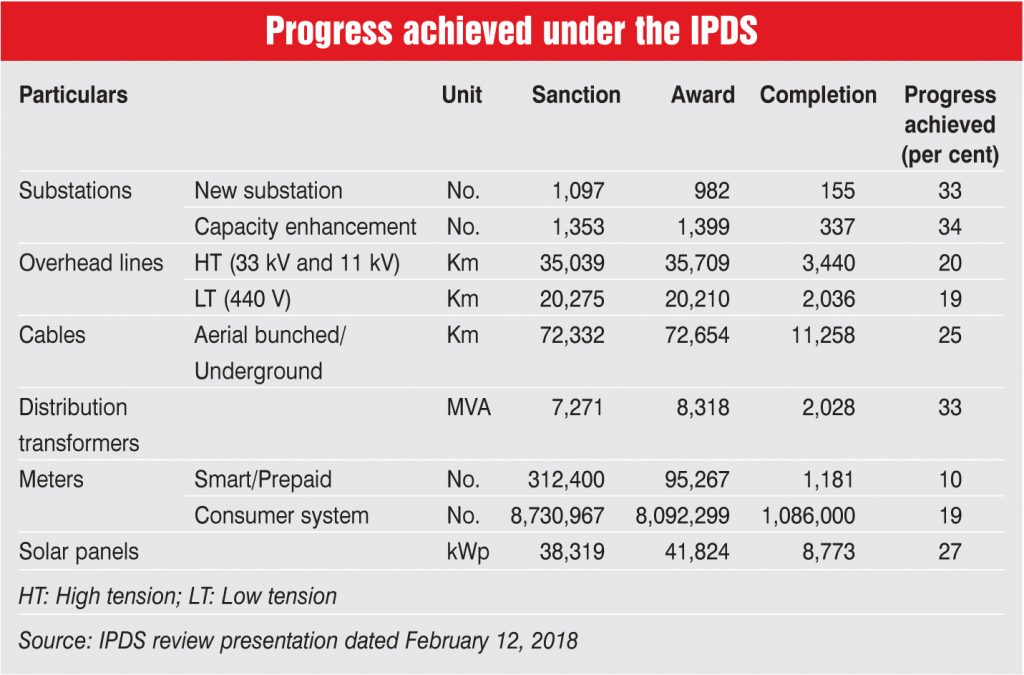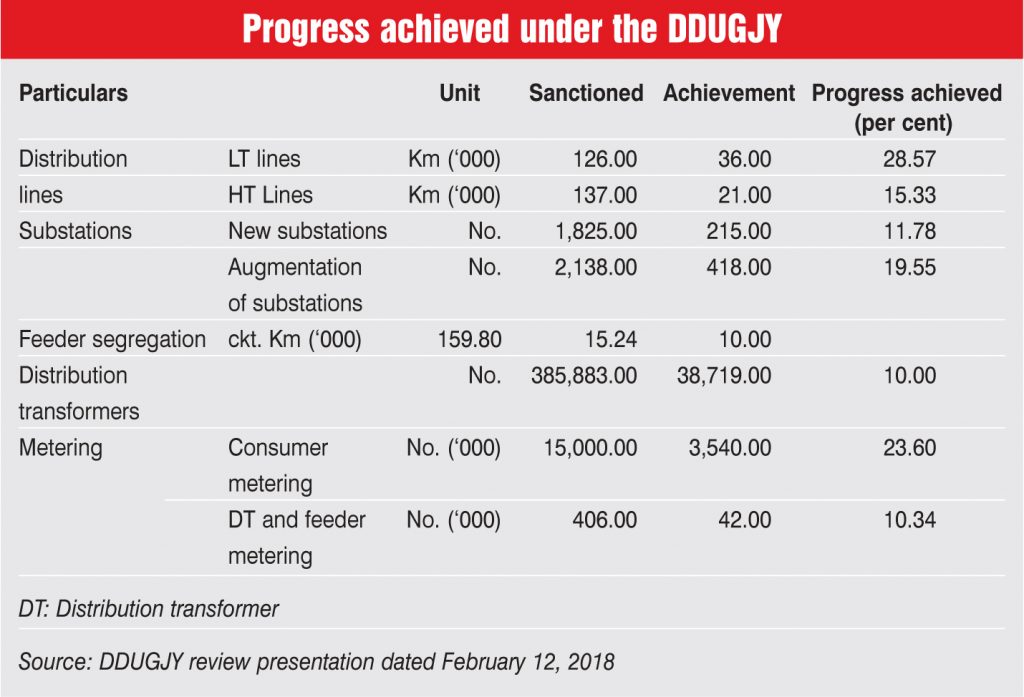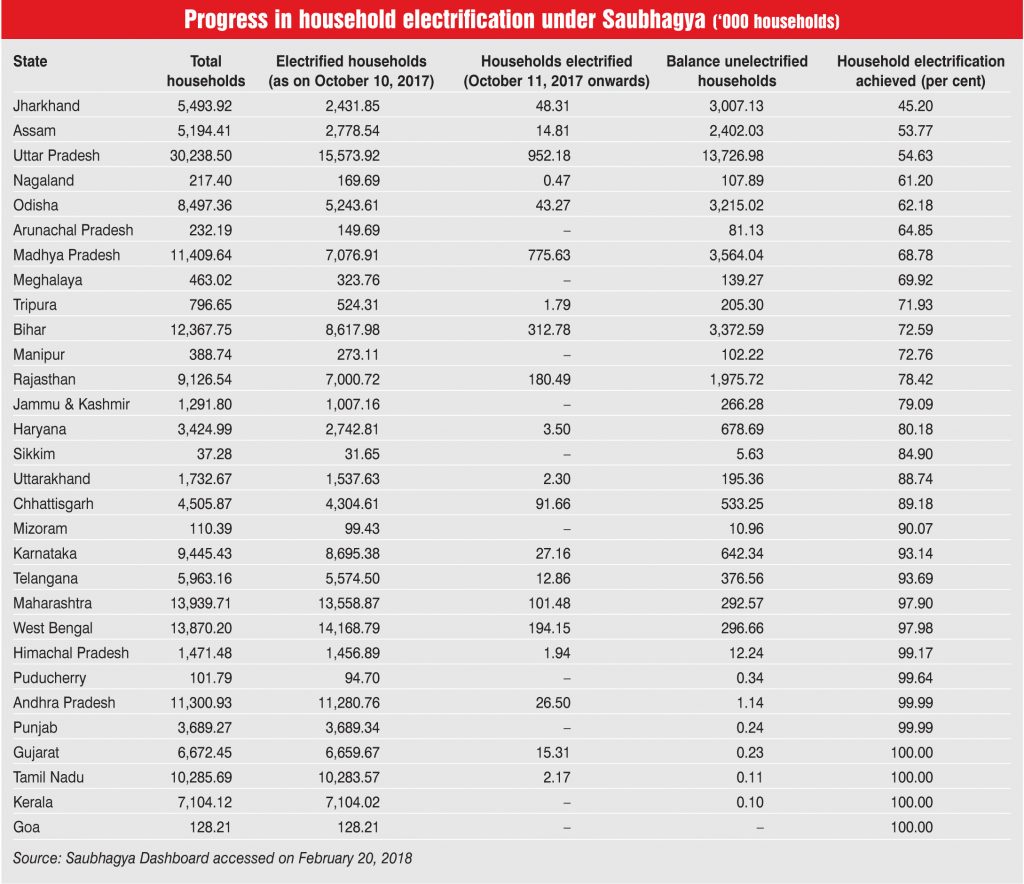
Over the past couple of years, several government schemes have been introduced in the power distribution segment to provide 24×7 quality and reliable power supply to all. The latest among these is the Pradhan Mantri Sahaj Bijli Har Ghar Yojana (Saubhagya), which has set an ambitious target of 100 per cent household electrification by March 2019. The two flagship schemes in the power distribution segment, namely, the Integrated Power Distribution Scheme (IPDS) and the Deendayal Upadhyaya Gram Jyoti Yojana (DDUGJY), launched in 2014, are progressing steadily as well. These schemes, which are aimed at strengthening sub-transmission and distribution (T&D) infrastructure in the country, are doing well in states such as Telangana, Andhra Pradesh, Gujarat and Karnataka, while Jammu & Kashmir and Jharkhand are lagging behind.
Saubhagya
The Saubhagya scheme was launched on September 25, 2017, with the aim of providing electricity to every willing household in rural and urban areas by March 2019. The scheme is different from all other schemes targeted at rural electrification as they focused on village electrification and not on providing last-mile connectivity. Under the scheme, a total of 31.8 million households are proposed to be electrified across 21 states, which have submitted letters of intent.
The scheme entails a total outlay of Rs 163.2 billion, including a gross budgetary support of Rs 123.2 billion, of which Rs 105 billion (almost 85 per cent) has been earmarked for rural household electrification. The remaining Rs 17.32 billion has been kept for unelectrified urban households, which are fewer in number. The projects will be funded by grants provided by the central government (60 per cent) and the respective state governments (10 per cent) as well as through loans (30 per cent). There is no upfront allocation of funds and the projects will be sanctioned on the basis of detailed project reports submitted by discoms.
Under the scheme, free-of-cost electricity connections are being provided to those unelectrified households that have at least one deprivation as per the Socio-Economic Caste Census data in rural areas. Others are being charged a sum of Rs 500 per household in 10 equal instalments to be added to the bill. Under the scheme, consumers are provided single-phase electricity connections with service line cable, prepaid/ smart meters, single-point wiring, LED lamps and associated accessories in line with the Central Electricity Authority’s technical specifications and construction standards. The scheme also includes a provision for last-mile connectivity infrastructure including poles and conductors. For unelectrified households in remote or inaccessible areas, solar photovoltaic-based stand-alone systems including power packs of 200-300 Wp (with battery bank) with maximum five LED lights, one DC fan, one DC power plug along with repair and maintenance service for five years are provided.
In terms of progress, 2.81 million households have been reported to be electrified under the scheme as of February 20, 2018. This represents about 8 per cent of the total households that were unelectrified at the time of the launch of the scheme. Madhya Pradesh, Bihar, West Bengal, Uttar Pradesh and Rajasthan together account for over 85 per cent of the total households electrified under the scheme. However, none of the households in Arunachal Pradesh, Meghalaya, Manipur, Jammu & Kashmir, Sikkim and Mizoram were electrified. The states of Gujarat, Tamil Nadu, Kerala, Goa, Andhra Pradesh, Punjab, Puducherry and Himachal Pradesh have achieved almost 100 per cent household electrification. Meanwhile, Jharkhand (45.2 per cent), Assam (53.77 per cent), Uttar Pradesh (54.63 per cent), Nagaland (61.2 per cent) and Odisha (62.18 per cent) have the lowest household electrification levels.
IPDS
Launched in 2014, the IPDS aims to provide quality and reliable 24×7 power supply in urban areas. As of February 8, 2018, a total of Rs 284.05 billion has been sanctioned under the scheme. This includes government grant of Rs 176.23 billion, of which Rs 48.77 billion has been released. Of the total sanctioned outlay, Rs 268.32 billion is for system strengthening of the sub-T&D network in 3,616 towns across 545 circles; Rs 9.85 billion is for information technology (IT) enablement of discoms; and Rs 5.88 billion is for enterprise resource planning.
As of February 8, 2018, projects worth Rs 242.84 billion have been awarded for system strengthening, representing around 91 per cent of the project work. Further, around 21 per cent of physical infrastructure sanctioned under the scheme has been erected. This includes 155 new substations, 5,476 km of distribution lines, 11,258 ckt. km of aerial bundle cable, 1,181 smart meters, 1,086,000 consumer meters, 2,028 MVA of transformer capacity, and 8,773 kWp of solar power capacity. Amongst the states, Andhra Pradesh, Gujarat and Uttar Pradesh have set up over 40 per cent of the sanctioned infrastructure, Tripura has set up 31-40 per cent, and Kerala, Karnataka, Manipur and Telangana have completed 11-20 per cent. However, Andaman, Arunachal Pradesh, Delhi, Goa, Himachal Pradesh, Jammu & Kashmir, Meghalaya, Puducherry and Sikkim have not commissioned any physical infrastructure.
Under IT Phase II of the IPDS, which entails IT-enablement of 2,600 urban towns, Rs 9.85 billion has been sanctioned for 1,932 towns across 24 states. For this, projects have been awarded in Uttarakhand and Punjab. In 10 states, requests for proposal (RfPs) have been floated, and in another five states RfPs are under preparation. Meanwhile, Jammu & Kashmir and Jharkhand are yet to initiate action.
On the feeder monitoring front, of the total 31,408 feeders, around 28,049 (or 90 per cent) are being monitored on the national power portal. For registering consumer complaints, 47 public discoms and 11 private discoms have made the short code “1912” operational. The discoms of four states, Arunachal Pradesh, Nagaland, Mizoram and Meghalaya, are yet to implement the code. Of the discoms that have adopted the short code, the discoms of Tamil Nadu and Punjab are yet to make the number toll-free.
Under the erstwhile Restructured Accelerated Power Development and Reforms Programme (now subsumed under the IPDS), Rs 53.74 billion has been sanctioned (Rs 34.94 billion disbursed) across 1,405 towns for IT Part A; Rs 12.51 billion has been sanctioned (Rs 4.37 billion disbursed) for supervisory control and data acquisition (SCADA) Part A across 59 towns; and Rs 308.97 billion has been sanctioned (Rs 64.7 billion disbursed) across 1,227 towns for distribution Part B. In terms of physical progress, go-live status has been achieved in 1,375 towns of the total 1,405 towns. Further, SCADA has been deployed in 52 of the total 59 towns, and is operational in 20 towns.
DDUGJY
Launched along with the IPDS in December 2014, the DDUGJY targets electrification of all villages and strengthening of sub-T&D infrastructure in rural areas. As of December 2017, 636 projects worth Rs 425.65 billion have been sanctioned under the scheme including government grant of Rs 326.07 billion, of which Rs 55.94 billion has been released. The state utilities have awarded 597 projects aggregating Rs 417 billion. Of the projects yet to be awarded, 21 are in Jammu & Kashmir, two are in Uttarakhand, seven in Meghalaya, six in Himachal Pradesh, two in the Andaman & Nicobar Islands, and one in Arunachal Pradesh.
Village electrification has made significant progress under the DDUGJY scheme. Of the 18,452 unelectrified villages as of April 2015, only 945 villages (excluding grazing reserves and uninhabited villages) remain to be electrified as of February 20, 2018. These villages are scheduled to be electrified by May 1, 2018.
With regard to physical infrastructure set up under the DDUGJY, 57,000 km of distribution lines (both high tension and low tension), 215 new substations (12 per cent of the total number) and 38,719 distribution transformers (10 per cent) have been installed. Further, around 3,540 consumer meters (24 per cent) have been installed and feeder segregation of up to 15,240 ckt. km (10 per cent) has been achieved.
Conclusion
To conclude, progress on new infrastructure under the IPDS and DDUGJY has been tardy owing to clearance delays, limited availability of data, lack of coordination between various departments, etc. However, with the government planning to fast-track the award of projects under these schemes, better progress is expected in the near future. Further, the timelines set under Saubhagya are too tight. Besides, the large number of new rural connections will have an adverse impact on the financial health of the discoms, which needs to be effectively managed.






